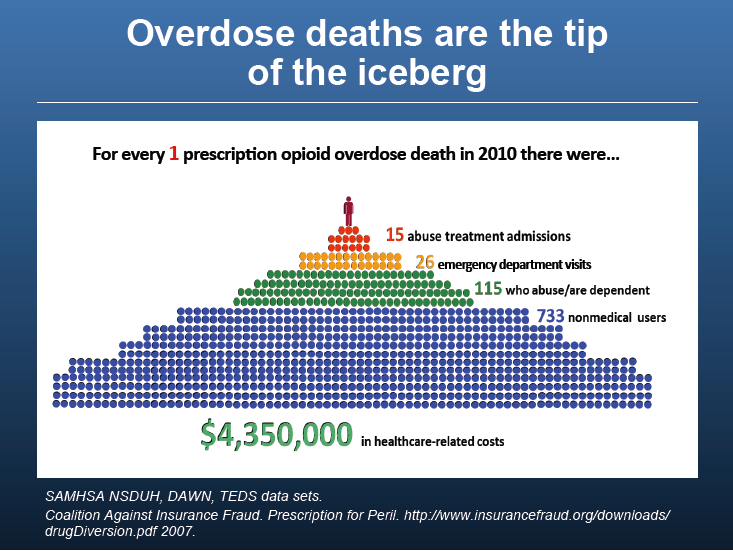The Oregon Coalition for Responsible Use of Meds known as OrCRM has been tasked by the National Governor’s Association to implement steps aimed at reducing the number of people addicted to and dying from the overuse of prescription drugs such as hydrocodone, oxycodone and morphine.
“This is an epidemic of diabetes and heart disease proportions,” said Dr. Chuck Hofmann, clinical consultant for the Eastern Oregon Coordinated Care Organization.
In 2012, there were 3.7 million legal prescriptions for opioids dispensed in Oregon, according to the local NGA task force on prescription drug abuse. That is a minimum of 100 million tabs in circulation with a population of 3.9 million. Between 2000 and 2011, the state’s rate of death due to unintentional prescription drug overdoses increased by 2.4 times, and the rate of hospitalization increased fivefold, the task force stated in a letter to Gov. John Kitzhaber. From 2000 to 2012, 4,182 people died from opioids overdoses, that’s about 322 a year.

The coalition, led by Lines for Life, will hold its first of about five or so summits across the state in Eastern Oregon on Feb. 27. The goal is to find ways to implement recommendations that came out of summits convened in 2010 and 2011 by Lines for Life and events convened by Kitzhaber in 2012 and 2013 and ideas that came out of the NGA on prescription drug abuse.
The summits will look at six areas to try and reduce the problem: decrease pills in circulation, promote a prescription drug monitoring program, educate patients, change attitudes and perceptions, reduce the volume of unwanted pills and improve and expand access to treatment services.
It’s all tall order but advocates are hoping that bringing together a wide range of community members will give them a better chance at success.
“This is a project that just goes well beyond the CCOs, this is not just the Medicaid population. This is the entire population,” said Lines for Life CEO Dwight Holton. He expects 150-200 people to show up for the day-long event that will include a presentation on the data and break out groups tasked with looking at ways to combat the issue.
Over prescribing
Health experts say medical providers started doling out more prescription pain medications about a decade or so ago when officials realized in discussions on medical marijuana and assisted deaths that they weren’t adequately treating pain.
But it turns out these prescriptions drugs aren’t that effective in treating chronic pain.
“The literature really does tell us that these drugs are really not that effective in treating pain,” said Dr. David Labby, chief medical officer of HealthShare of Oregon. “It’s not going to make your pain go away.”
It became somewhat of a self-perpetuating problem. Doctors were somewhat liberally prescribing narcotics to deal with pain. Patients became hooked but the drugs weren’t working.
“Then we have this unintended consequence of people dropping dead because of overuse of these narcotics,” Hofmann said.
And the problem extends to what happens with unused pills. A lot of them end up on the black market and in the wrong hands, Hofmann said. But not every provider or healthcare worker knows the whole picture, he added.
In Oregon there is enough hydrocodone being prescribed for every man, woman and child to have 30 pills, Hofmann said. “A lot of prescribers would be absolutely shocked to know where these pills are ending up.”
Part of the problem is that clinics are understaffed, and it’s easier for a doctor to prescribe pills than argue with a patient for 45 minutes about better options.
“And then providers end up throwing their hands in the air,” Hofmann said.
Come together
Officials say the writing is on the wall and years of work has given healthcare officials and other leaders the data and tools they need to start making a difference.
“We know where we want to be,” Hofmann said. “We know where we are.”
Efforts are already underway in many parts of the state, including the Portland metro area. Multnomah County Health Officer Paul Lewis said officials have been working at this issue for years.
He said many in the area are trying to develop a regional standard on safe prescribing, a monitoring system to ensure guidelines are being followed, education of providers, patients and the general public, addiction treatment and medically assisted treatment for substance abuse.
Part of the solution also is getting patients to find other ways to deal with their pain such as acupuncture, physical therapy, relaxation methods and more, according to experts.
And everyone agrees the key is getting everyone involved to the table.
“Really the community has to come together and decide what the standard is for that community. It’s something that we all own,” Labby said. “I think most providers agree we have to be part of the solution because we are part of the problem.”
Hofmann said the problem is not going to be fixed overnight but that the upcoming summits are a step in the right direction.
“It took over a decade to get here and it’s going to take over a decade to get it fixed,” he said.
Shelby can be reached at [email protected].
FOR MORE INFORMATION
To review the National Governors Association Task Force Report
1. This is big problem for some if not all of Oregon's Tribal communities. I hope that organizers will reach out and include Tribes in the discussion.
2. Six areas of focus are identified above. I don't think you talk about this problem with an focus on the herion problem too. If you have success in the above six areas, one possible consequence will be to inadvertantly contribute to the herion problem.